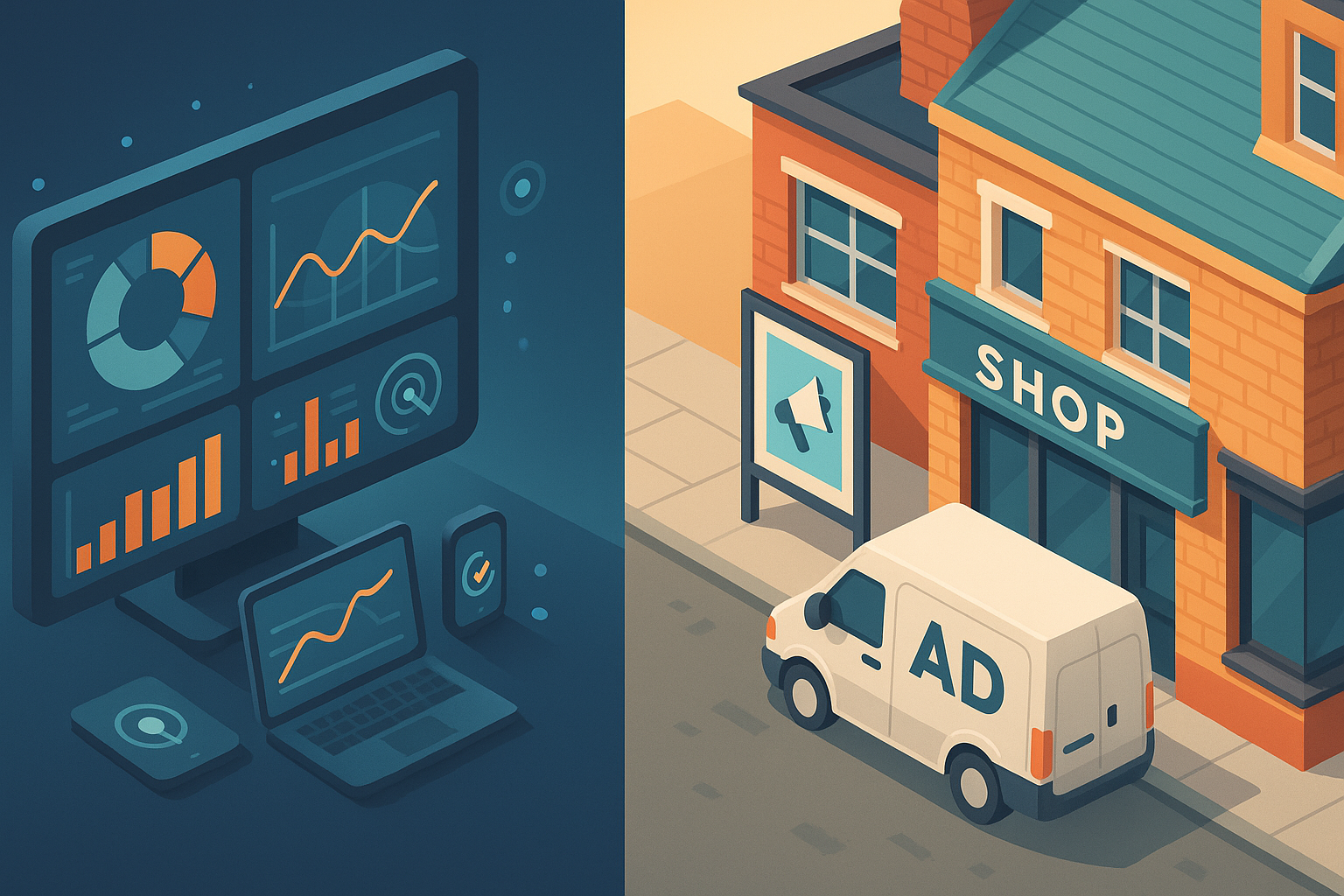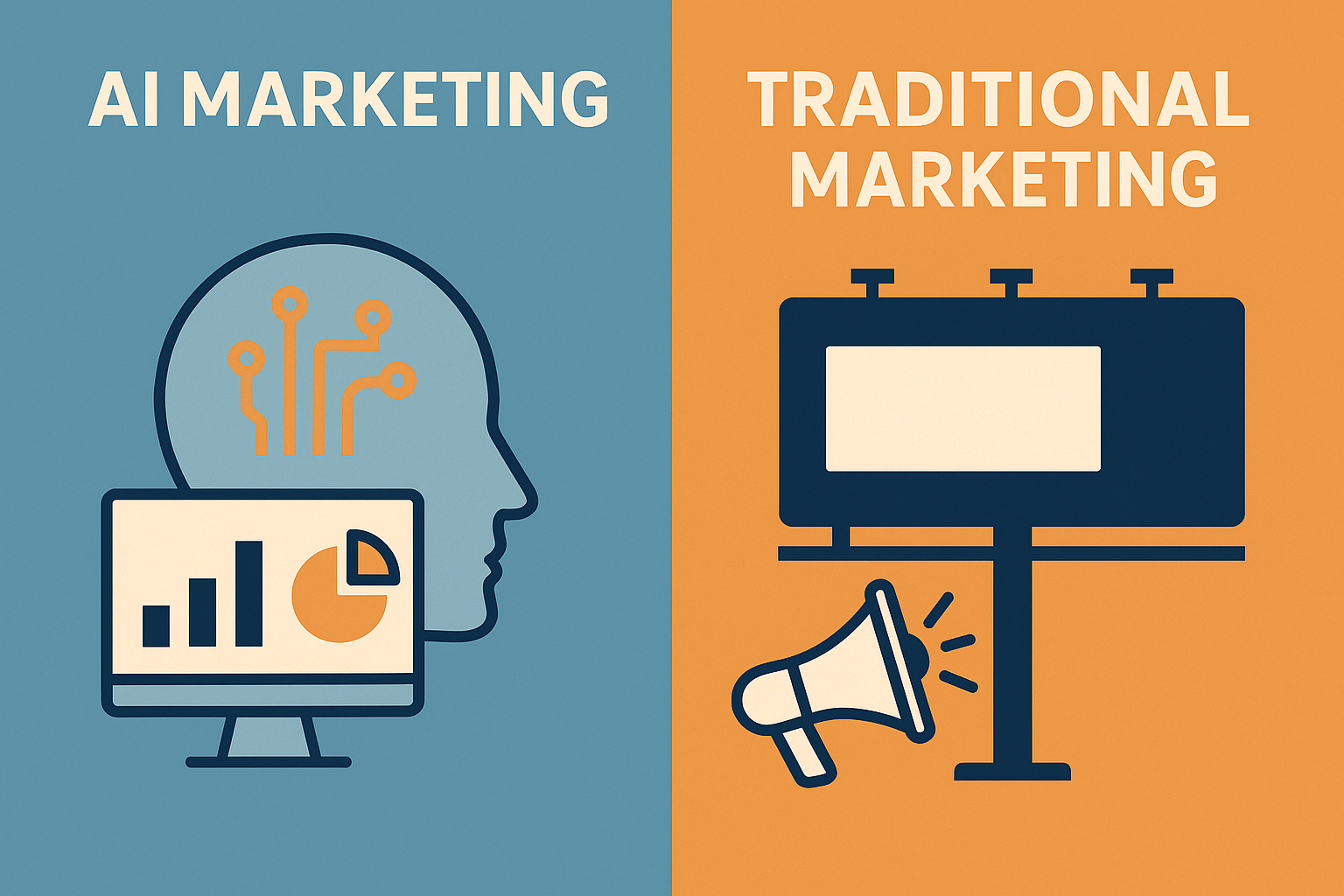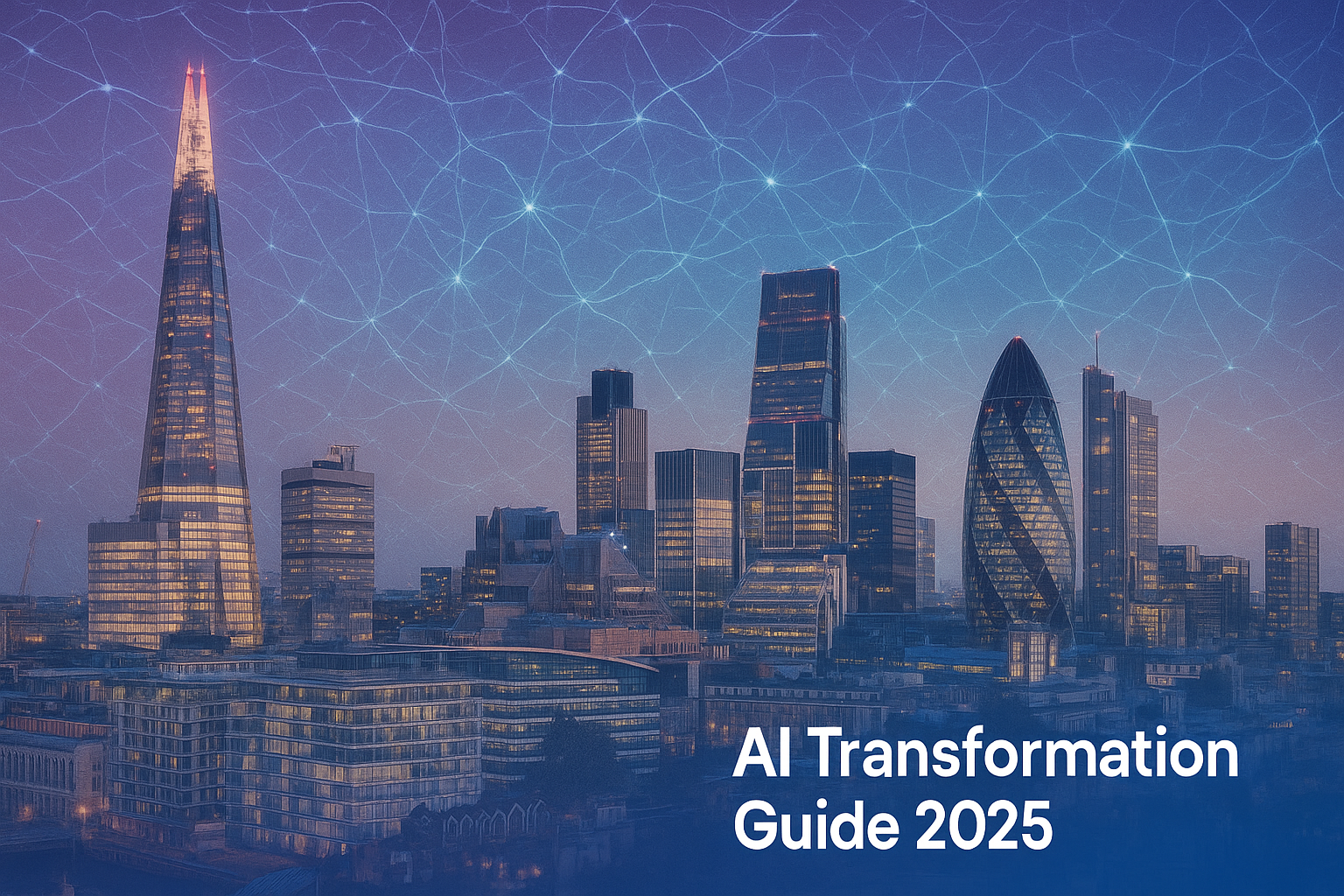Why Small Businesses Need Both AI and Traditional Marketing
Ever feel like your flyers or local newspaper ads disappear into thin air. At the same time, big brands somehow manage to reach the right people at the perfect moment? You're not imagining it. 76% of small businesses say they struggle to know if their marketing even works, while digital-first competitors are using AI to personalise offers and track results instantly.
The good news? You don't need a massive budget or a tech team to compete. AI marketing tools are now affordable, simple, and built for businesses like yours — cafés, salons, plumbers, boutiques, and neighbourhood shops that want more customers without wasting money.
Think of it this way:
- Traditional marketing is visibility — your poster in a shop window or logo on a van makes you familiar in the community.
- AI marketing is precision — showing your offer to the exact people who need it, right when they're searching for it.
- The magic happens when you mix both, building trust locally while reaching the right customers online.
By the end of this guide, you'll understand how AI and traditional methods work differently across the areas that matter most to your business:
- Where your customers see you (channels and platforms)
- How you connect with them (targeting and engagement)
- What you spend and what you get back (costs and ROI)
- How fast can you adapt if things change
The real win is knowing which tool to use, when. Sometimes you'll want a big net to raise awareness. Other times, a laser-focused spotlight will get better results for less spend.
So, whether you're pouring coffees in East London, running a family salon in Surrey, or fixing pipes across town, this comparison will help you choose more innovative strategies that fit your budget — and your time.
Let's start by looking at the foundations of AI vs traditional marketing, so you can see exactly how they differ, and why that matters for your business growth.
Understanding the Foundations of AI vs Traditional Marketing
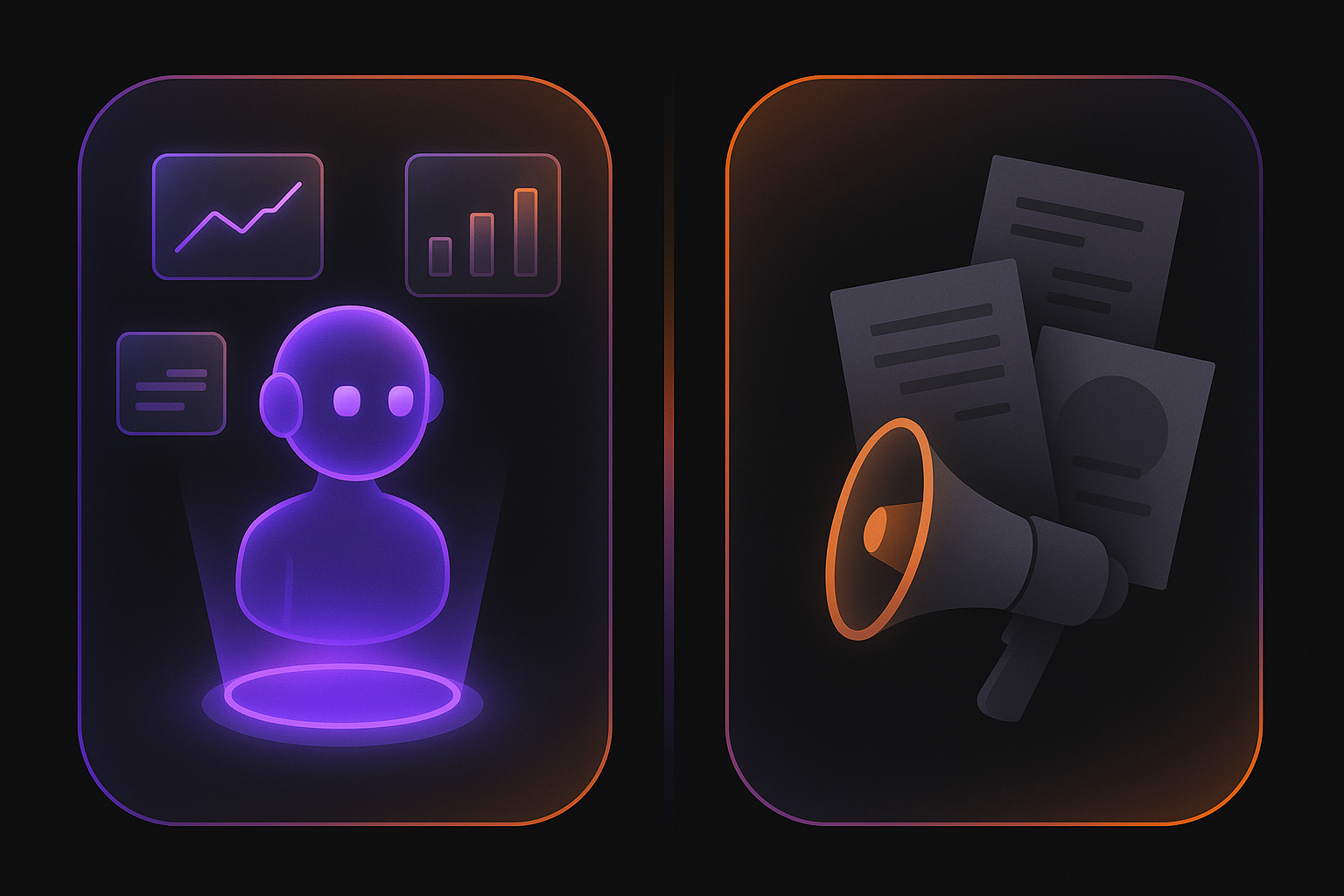
When you hear "AI marketing," think data, automation, and personalisation. It's the use of innovative tools that learn from customer behaviour — spotting patterns, predicting what people want, and automatically delivering the right offers at the right time.
By contrast, traditional marketing is built on intuition and broad messaging. Instead of personalised touchpoints, it leans on methods like print, radio, and flyers to reach as many people as possible at once.
Picture this: AI is like a super-smart assistant who knows your customers' names, preferences, and buying habits. Traditional marketing is like shouting in the town square; you'll reach plenty of ears. Still, not all of them will actually care about your message.
AI Marketing in Plain English
AI takes the guesswork out of connecting with your audience. It works by:
- Collecting and analysing customer data in real time
- Automating repetitive tasks like emails or social media posts
- Creating personalised experiences at scale
For example, a café in London could use AI to automatically show cappuccino ads to morning commuters scrolling Instagram and switch to dessert offers by evening — all without lifting a finger.
Traditional Marketing at a Glance
Traditional methods focus on mass visibility and community presence. They typically include:
- TV, radio, and print media
- Flyers, posters, and billboards
- In-person events and sponsorships
A local plumber might run newspaper ads or brand their van — great for trust-building and familiarity, but with little ability to measure exactly who saw it or why they responded.
Why This Matters for Small Businesses
The big difference comes down to precision vs. reach.
- AI lets you target the exact customers most likely to buy — and measure every penny spent.
- Traditional gives broad awareness and local recognition, but with less certainty or control over results.
For a small business owner, that means AI can feel like having an extra teammate working 24/7. At the same time, traditional helps you stay visible in your community. The most brilliant strategy often blends both.
Channels and Platforms: Where Customers Meet Your Brand
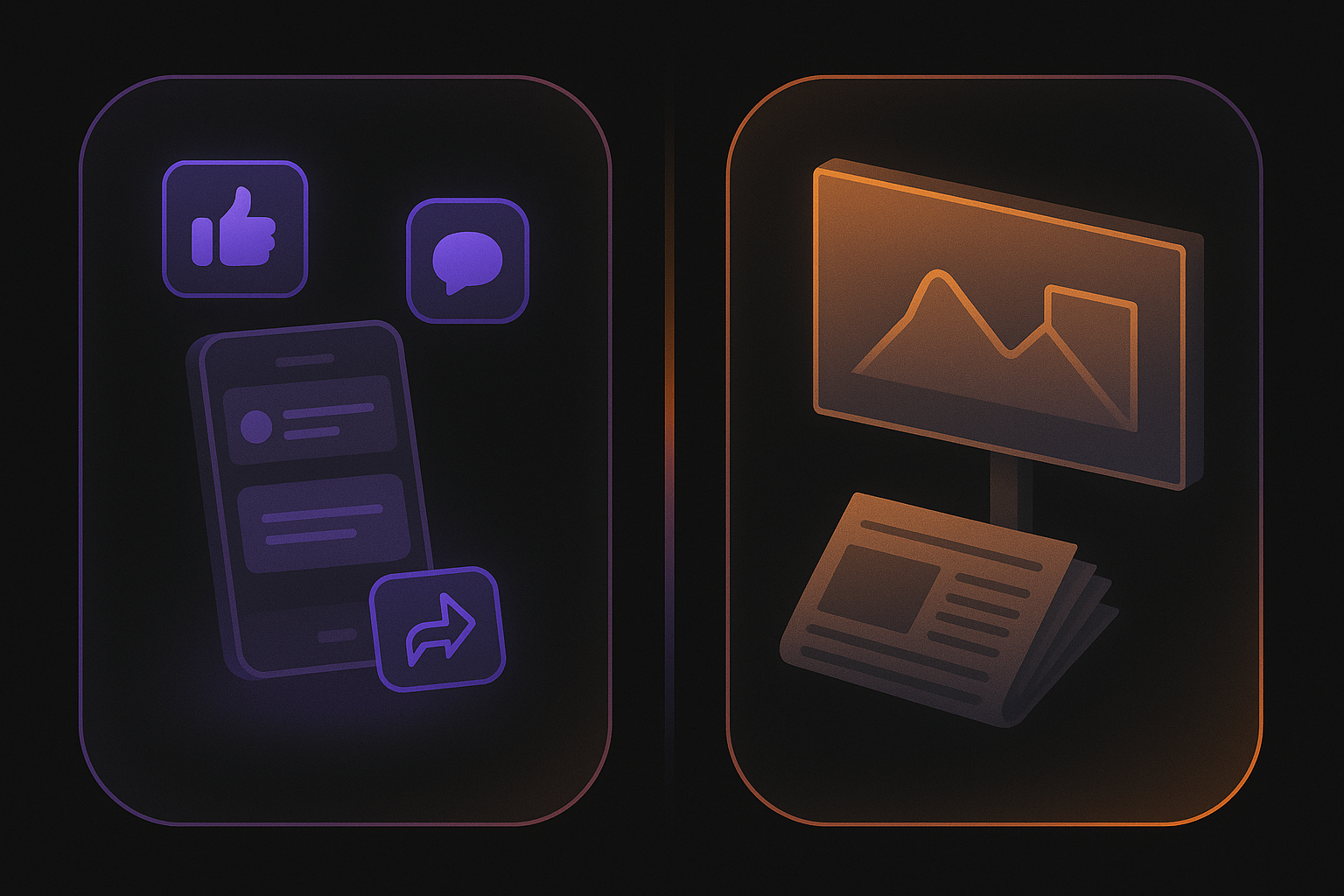 chatbots
chatbots
Finding your customers today is about knowing where they spend their time. Some scroll through Instagram, others still flip through the local paper. The trick is understanding the difference between AI-driven digital platforms and traditional offline channels — and how to use both wisely.
AI Marketing Channels
AI thrives in spaces where your customers leave digital footprints every day. These include:
- Social media ads fine-tuned to audience behaviour
- Search engine results showing your business when people are actively looking
- Email automation that sends the right offer at the right time
- Chatbots that answer questions instantly, 24/7
- Recommendation engines that suggest products based on browsing history
Picture this: a café owner doesn't manually set up ads. Instead, AI notices regulars searching "best coffee in London" and automatically serves your promo in their Instagram feed. That's precision at work.
Traditional Marketing Channels
Some methods never honestly go out of style — especially when you want to plant your brand in the local community. Popular channels include:
- Print ads in local newspapers and magazines
- Radio or TV spots for regional visibility
- Billboards and flyers grab commuters' attention
- In-store promotions or events that create face-to-face trust
A plumber, for example, might sponsor the local paper or drive a van with bold branding. Neighbours spot it daily, and suddenly the business feels familiar and reliable.
Strategic Takeaway
Think of it this way: traditional marketing is visibility, AI marketing is precision. Flyers reach hundreds of people, but AI ensures your message lands in front of the right hundred people who are most likely to buy.
Small businesses don't need to choose one or the other. The most innovative approach is often mixing both worlds — using traditional tactics to build local credibility and AI tools to drive scalable, measurable growth online.
The key is balance: let traditional marketing make you memorable in your community and let AI ensure you're unforgettable when customers pull out their phone or laptop.
Targeting and Personalisation: Casting a Net vs Using a Laser Pointer
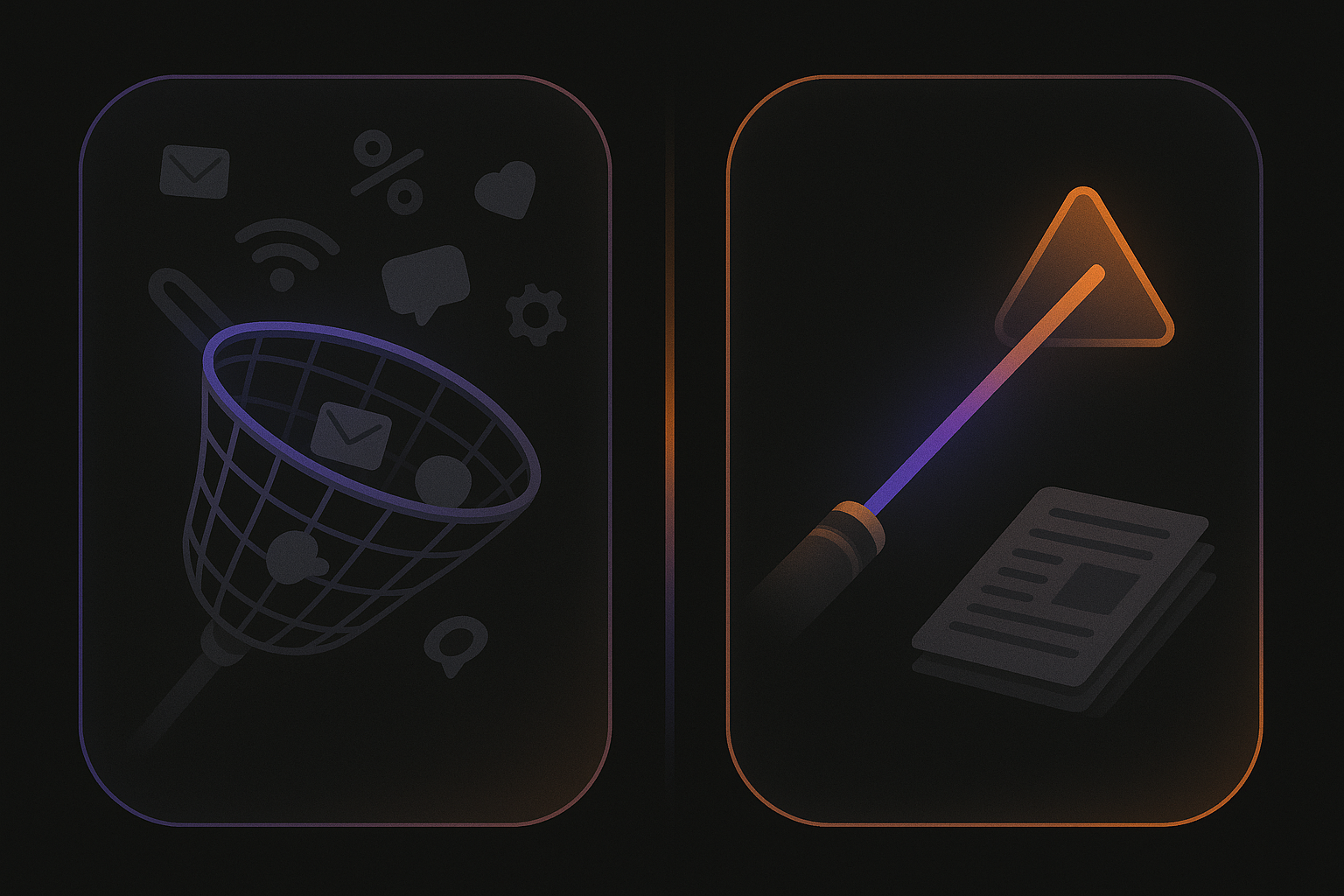
AI's Precision Targeting
Think of AI marketing like a laser pointer—it finds exactly who you want to reach and speaks directly to them. Using
predictive analytics, and machine learning to identify the likelihood of future outcomes. Helps businesses anticipate trends and make data-driven decisions.|global|/glossary#predictive-analytics]GLOSSARY~~ and customer data, AI segments audiences into specific groups rather than lumping everyone together.For a small business, this means:
- Personalised offers delivered in real time (e.g. a salon automatically sending a birthday discount)
- Social ads that show up only in front of people who match your ideal customer profile
- Emails tailored to individual behaviours — like reminding a café regular when their usual order is available again
Picture this: your café shares a latte special, and AI ensures it lands in the Instagram feed of locals most likely to buy. No guesswork, no wasted flyers.
Traditional Broad Targeting
Traditional methods work more like casting a big net in the ocean. You'll catch some of the right fish, but plenty that aren't interested in you.
With demographics-based targeting, you can choose key demographics such as age, gender, or location. Still, you can't narrow it down much further.
- Flyers, billboards, or newspaper ads hit everyone in town, whether they're your customer or not
- Campaign messages are broad, one-size-fits-all—great for visibility, but less personal
Example: a plumber investing in a newspaper advert builds recognition, but only a fraction of readers may actually need plumbing services at that time.
Key Difference
Here's the punchline: AI = precision and scale; Traditional = broad but less relevant reach.
AI makes it possible to spend less and connect deeper by showing the right message to the right person at the right time. Traditional methods are still fantastic for building community visibility and trust. Still, they can't match AI's ability to personalise every touchpoint.
For small businesses, the takeaway is simple—use AI when you want a direct response, and traditional when you want broad awareness. The most brilliant strategy often blends the two.
Data and Decision-Making: Intuition vs Real-Time Insights
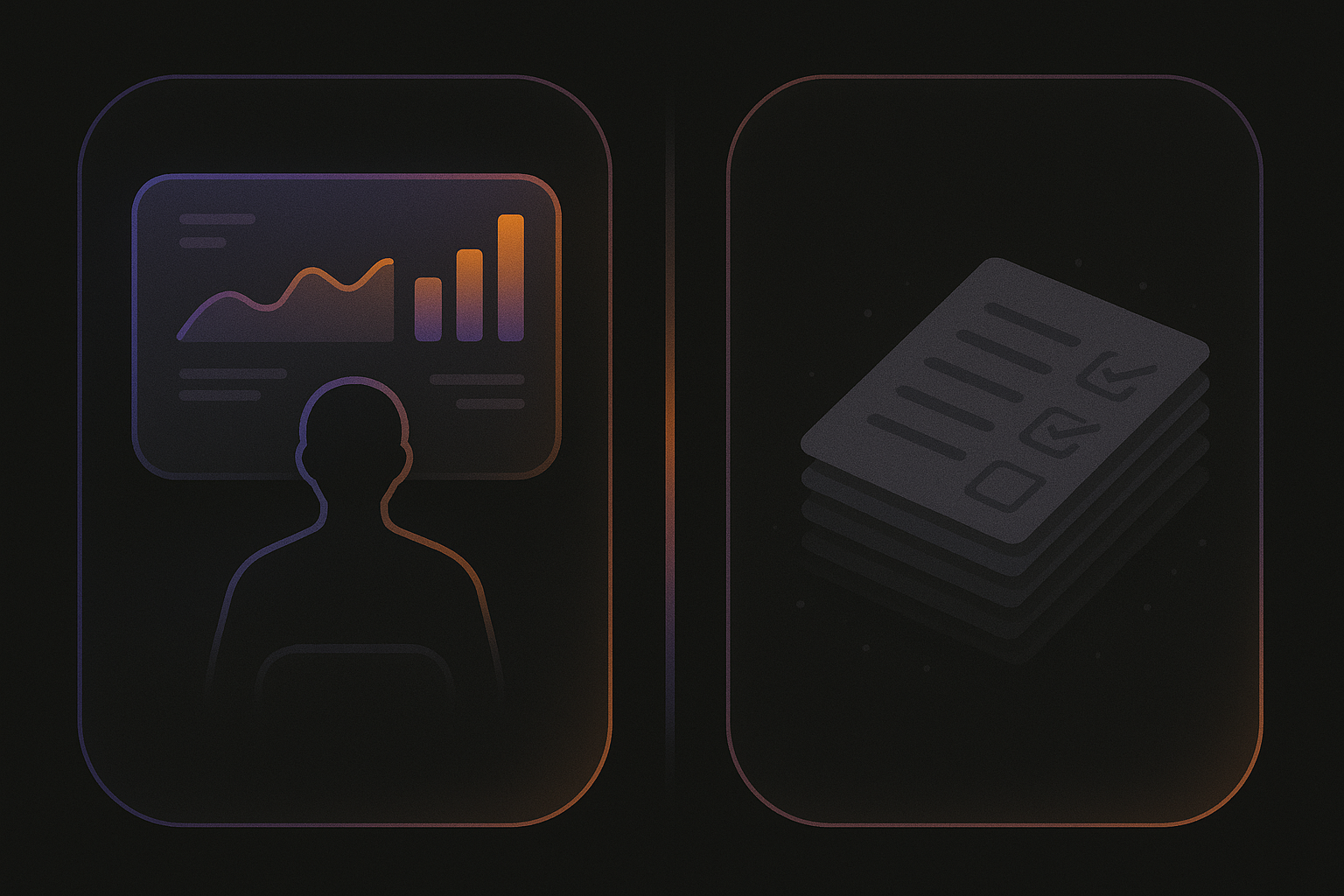
When it comes to marketing decisions, the most significant difference between AI and traditional methods is the speed and accuracy of the data.
AI gives you insights instantly, while traditional marketing often leaves you waiting weeks or months for answers. Picture the contrast: one is like checking real-time traffic on Google Maps, the other is reading last year's road report.
AI Marketing and Data Utilisation
AI marketing thrives on big data, algorithms, and feedback loops that are constantly improving.
Instead of guessing what your customers want, AI looks at live signals such as clicks, comments, purchases, and even weather trends.
For small businesses in 2025, this level of insight is no longer expensive. Affordable subscription tools now make it possible for cafés, salons, and local shops to:
- Track performance in real time through simple dashboards
- Automatically test different ads or offers
- See which campaigns bring actual sales without manual spreadsheets
Think of AI as the assistant who whispers, "Your Facebook ad isn't working—switch the photo now" before you've even wasted your budget.
Traditional Data Approaches
Traditional marketing relies more on surveys, focus groups, and gut instinct.
- Results are often delayed, sometimes by weeks
- Insights are less precise and based on averages
- Professional research can cost thousands — out of reach for most small businesses
It's like throwing leaflets through every letterbox and hoping one lands in the hands of a willing customer. You'll get reach, but not much precision.
Business Impact
With AI, you make faster, sharper decisions driven by data rather than hunches.
Traditional methods are slower, riskier, and often more costly to correct if a campaign misses the mark.
Here's the reassuring part: you don't need to be a data scientist to use AI tools. Most are built with simple, friendly dashboards so you can instantly see what's working and what's wasting money.
The takeaway is clear: AI turns decision-making from guesswork into confidence. Suppose traditional marketing is like fishing with a wide net. In that case, AI is handing you a laser pointer to aim exactly where the fish are.
Adaptability and Campaign Agility
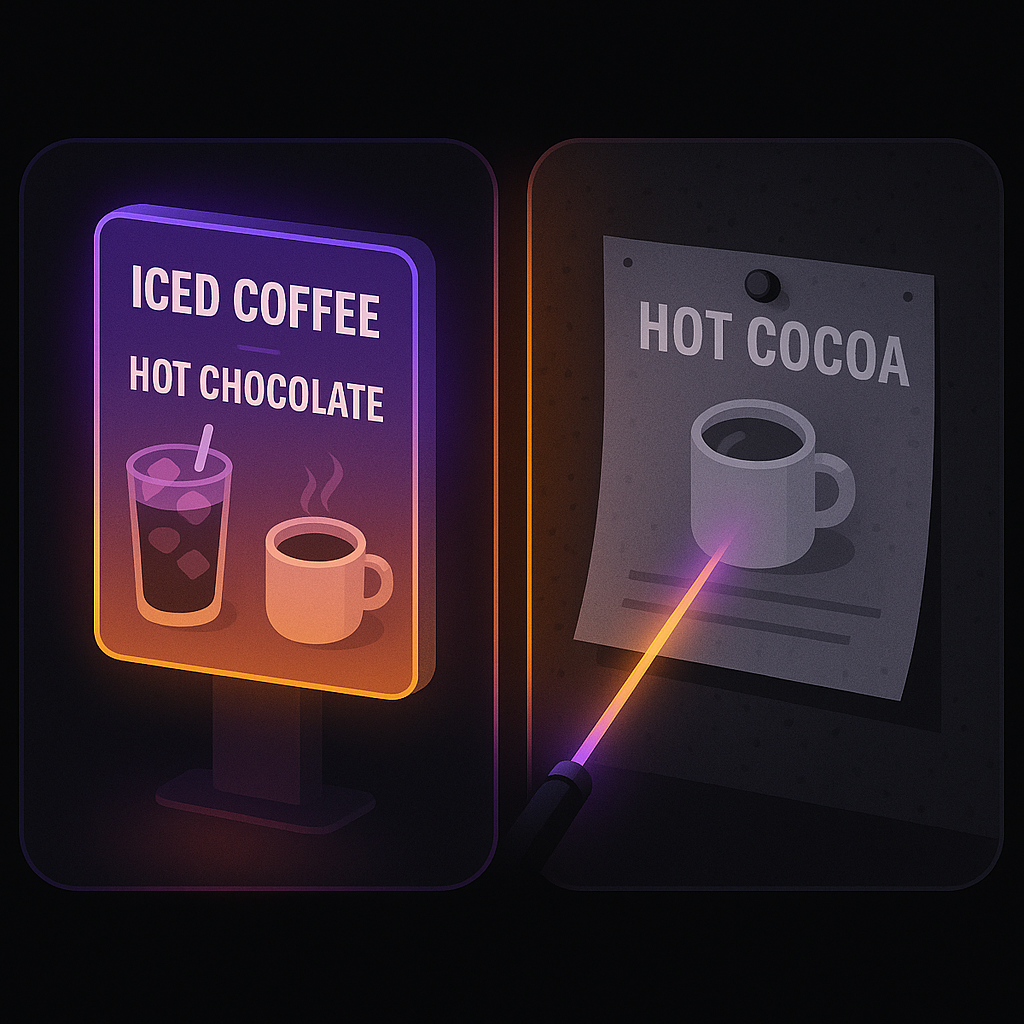
AI's Real-Time Adjustments
Think of AI marketing as having a digital assistant that never sleeps. It watches your campaigns in real time and makes changes instantly.
If an ad isn't performing, AI can pivot within hours — or even minutes — instead of weeks. For example, a café running a promotion on iced coffees could see the ad automatically switch to hot chocolate when the UK weather suddenly turns cold and rainy.
AI tools also:
- Track which designs, headlines, or offers get the most clicks
- Shift your budget to the ads that are actually driving sales
- Test multiple versions at once, then double down on what works
This agility means you're never stuck wasting money on a message that no longer resonates.
Traditional Campaign Planning
Traditional marketing, by contrast, is more like setting sail without a chance to update your course. Once you've printed flyers or booked a radio spot, you're locked in.
These campaigns often involve:
- Long lead times for design, printing, or media booking
- Fixed budgets that can't be reallocated mid-way
- Delayed feedback — you only know results once the campaign ends
That makes it harder to respond to trends, whether it's a viral social moment or a sudden shift in customer behaviour.
Contrast
The difference is simple: AI = fast and flexible; Traditional = slower, less nimble.
Picture this: your salon runs a glossy ad in the local paper for summer hair treatments. Two weeks later, demand shifts toward autumn colours, but your ad is stuck. With AI, your online campaign could have adjusted overnight, showing customers exactly what they're looking for now.
For small businesses, this adaptability is a lifeline. It saves money, keeps campaigns relevant, and helps you punch above your weight when competing with bigger brands.
In short, AI gives you the ability to "turn the ship on a dime." At the same time, traditional marketing relies on steady planning and patience. The smartest move? Use AI for agility, but lean on conventional methods when you want consistency and community recognition.
Costs, Efficiency, and ROI
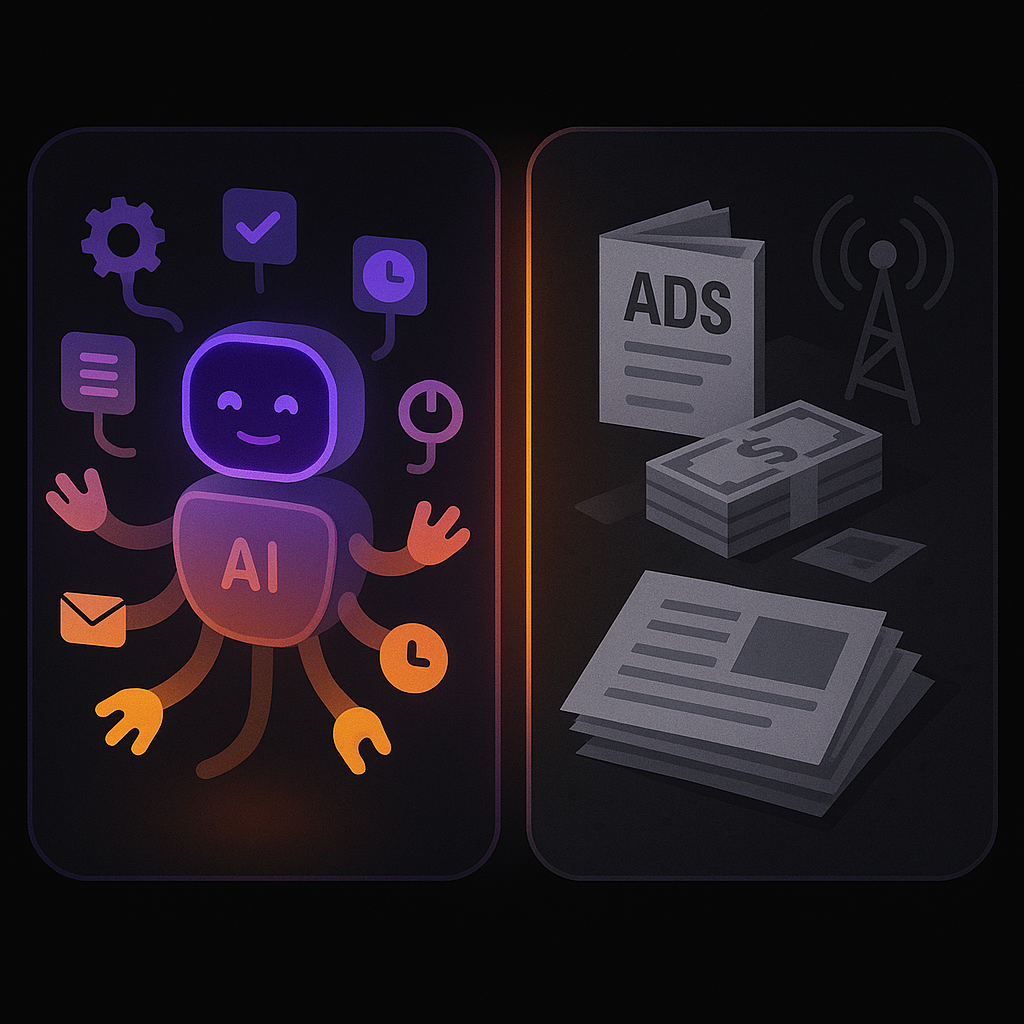
When you're running a small business, every pound counts. That's why understanding the cost-efficiency difference between AI marketing and traditional marketing can help you choose more innovative strategies that stretch your budget further.
AI Cost Efficiency
AI tools thrive on automation, meaning they handle the jobs that eat up your time — sending emails, posting on social media, or analysing campaign results.
- Automates repetitive tasks like scheduled emails, social posts, and customer reminders
- Lowers long-term costs because campaigns can run with minimal extra staff time
- Accessible through affordable subscription tools (many under £50/month by 2025)
Picture this: a local salon sets up AI email software. Customers automatically receive birthday discounts, saving the owner hours of admin while increasing bookings. No expensive ad agency required.
"AI is like hiring a staff member who works 24/7 — but only costs the price of a monthly app."
Traditional Marketing Costs
Traditional campaigns often mean higher upfront investment. Think printing stacks of flyers or buying a local radio spot.
- High initial spends for print runs, TV, or event sponsorships
- ROI is harder to track — you may know footfall increased, but not which ad caused it
- Works best for broad awareness, especially when reinforcing your visibility in the community
For example, a plumber can earn trust with a branded van or local newspaper ad, but measuring exact sales from that spend is tricky.
Comparative ROI
Here's the trade-off:
- AI delivers lower wastage and more transparent reporting — you see which campaigns brought in revenue directly
- Traditional offers prestige and reach sound when building a reputation, but with less accountability
A café owner could easily track how many lattes came from a Facebook AI-driven ad, but not always from a signboard outside the shop.
In short, AI marketing keeps your budget lean and trackable, while traditional marketing can still add weight and credibility. The most innovative businesses mix precision with presence — using AI for efficiency and data, while leaning on traditional to keep roots in the local community.
Scalability and Growth Potential
Scaling your marketing is about moving from "just reaching your street" to reaching your entire town, city, or even beyond — without losing efficiency or personality. Here's how AI and traditional methods stack up when it's time to grow.
AI Scalability
With AI tools, growing your reach is almost effortless. You can start small — say, promoting your café's new lunch menu to a few locals — and then extend to a wider London audience at the click of a button.
AI platforms automatically handle bigger data sets and keep the quality consistent. Whether you're serving 50 or 5,000 customers, each person can still get personalised emails, ads, or offers.
Picture this: your salon software remembers birthdays, preferences, and favourite treatments. As your customer base doubles, the system scales the reminders without you lifting a finger.
AI scaling in action:
- Expand campaigns from local to regional instantly
- Automate personalisation for thousands at once
- Cost stays predictable with subscription-style tools
Traditional Scalability
Traditional marketing expands, too, but it's rarely smooth. Reaching more people means more printing, more delivery, more human effort.
An electrician boosting visibility might scale from flyers in one borough to five. That's five times the printing, five times the door-to-door distribution, and five times the spend.
Where AI grows with data, traditional grows with workforce and budget.
Traditional scaling challenges:
- Higher upfront costs (print, events, radio buys)
- Logistics multiply as you expand
- Harder to personalise at scale
Guidance for Small Businesses
Here's the good news: AI lets a local shop "look big" without adding staff. You can run region-wide campaigns while still sounding like the trusted business owners next door.
Traditional methods still matter — they carry weight in local community trust. But when it's time to grow beyond word of mouth, AI gives you a scalable, affordable path forward that doesn't tie growth directly to extra costs.
The key takeaway? AI scales like software, traditional scales like paperwork. One multiplies effort automatically, the other by human hands. For small businesses, that difference can define how far and how fast you grow.
Customer Engagement and Relationships
When it comes to keeping customers interested, engagement is everything. Whether you run a café, salon, or plumbing service, how you stay connected makes all the difference between a one-time job and a loyal customer who keeps coming back.
AI tools and traditional methods tackle this in very different ways — and the sweet spot for small businesses is often using both.
AI Engagement Tools
AI gives you the ability to engage customers 24/7, without needing extra staff.
Common tools include:
- Chatbots that instantly answer FAQs on your website or Facebook page
- Automated responses for online enquiries or appointment bookings
- Triggered email flows that send reminders, special offers, or follow-ups automatically
Picture this: a salon client books online at 10pm. Instead of waiting until the morning, an automated system confirms instantly and even suggests an add-on treatment. That's the power of AI-driven engagement — fast, seamless, and always on.
The only catch? If overdone, it can feel "robotic". Customers may notice when messages aren't personalised enough, which is why authenticity still matters.
Traditional Engagement
Traditional methods win when it comes to trust and authenticity.
Think about:
- Face-to-face conversations at your shopfront or on the job
- Community sponsorships like local football kits or charity raffles
- Print materials such as flyers or loyalty cards handed over in person
These approaches build an emotional connection. For example, a plumber who sponsors the neighbourhood fête often becomes the "go-to" name in that community. Human presence leaves a lasting impression in a way no algorithm can replace.
Balanced Insight
AI helps you keep customers engaged in the background, while traditional engagement strengthens personal relationships.
The winning approach for small businesses is a hybrid model:
- Use AI to stay connected automatically (emails, chatbots, reminders)
- Use traditional methods to deepen trust locally (face time, sponsorships, conversations)
In short, AI keeps your brand present, traditional keeps it personal. Put them together, and you build loyal, community-rooted relationships with modern efficiency.
Measuring Feedback and ROI
Measuring marketing results is one of the most significant differences between AI-driven campaigns and traditional strategies. For small-business owners, this boils down to one question: "How do I know if my money is working?"
AI Measurement
AI marketing tools give you instant visibility into what's working and what's not. With dashboards and reports, you can track in real-time:
- Analytics dashboards that update live
Picture this: you run a café and launch a paid Instagram ad. Within hours, AI tells you that your "latte and pastry combo" ad drives 3x more clicks than your "sandwich deal" post. That kind of feedback means no wasted spend — just a clear view of "which penny brought which pound."
Traditional Measurement
With traditional methods, results come in weeks or months later — and they're often fuzzy. Measurement usually depends on:
- Coupon redemption slips
- Customer surveys or feedback cards
- Estimating foot traffic after an ad or flyer drop
The problem? It's harder to tell what truly worked. Was it the newspaper ad that brought in new customers, or did more people happen to walk past your shop? ROI here is often blurred, which can make it challenging to justify bigger spends.
Business Perspective
As a small-business owner, you probably want numbers you can trust before committing to a budget. AI delivers that reassurance with measurable proof, making it easier to scale campaigns confidently.
That doesn't mean traditional methods are useless — they can add qualitative depth, such as hearing what locals think about your service. But when it comes to day-to-day decision-making, AI provides the speed and certainty that helps you spend smarter, not bigger.
In short, if traditional marketing is like waiting for survey results, AI is like having a live scoreboard. The key takeaway? Clear feedback equals clearer growth decisions — and that's where AI gives small businesses a measurable edge.
Finding the Sweet Spot: Playing to Both Strengths
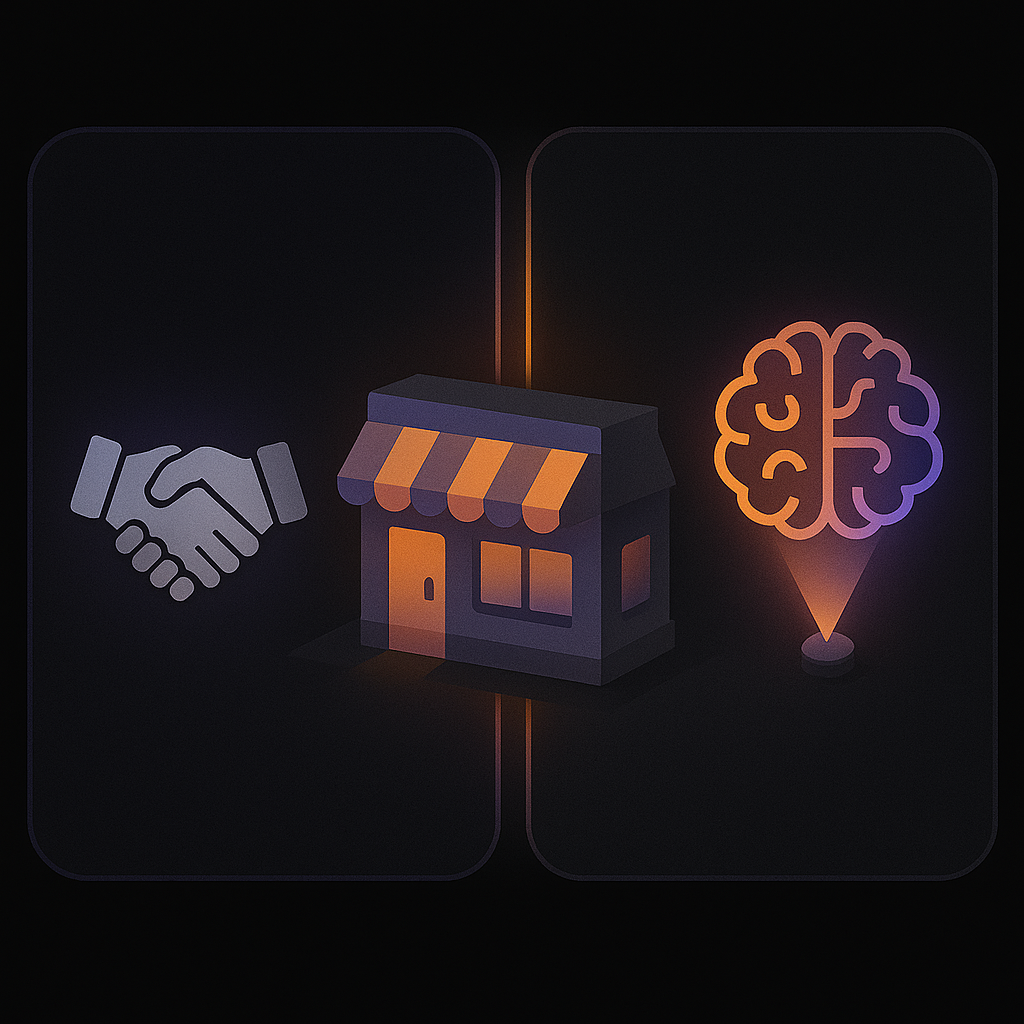
Blending AI marketing and traditional marketing isn't an either/or choice—it's about using each where it shines. Think of it like combining a high-tech sat-nav with a paper map: one gives you real-time guidance, the other grounds you in the local landscape.
When Traditional Still Wins
Some things AI can't replicate:
- Community events where you shake hands and chat with locals
- Printed flyers and posters that catch eyes in your shop window
- Local sponsorships (youth clubs, village fêtes, school programs) where presence matters more than pixels
These methods build trust and visibility in ways no algorithm can replace, especially valuable for family-run businesses rooted in their neighbourhood.
Where AI Outshines
AI tools thrive in areas where precision and speed are critical:
- Laser-focused targeting (ads shown only to people searching "best plumber near me" this week)
- Automated personalisation, like sending birthday rewards to salon clients
- Real-time adjustments, such as switching café ads from iced lattes to hot soups during a cold snap
Statistically, businesses using AI marketing see up to 30% higher
engagement rates compared to traditional mass campaigns, because the right message reaches the right person at the right time.How to Combine Both for Impact
The most brilliant strategy is to think "local heart, digital brain." Use traditional tactics to anchor your brand in the community, and AI to maximise efficiency and growth online.
For example: sponsor a local charity run (traditional), then follow up with AI-powered email campaigns to participants with thank-yous and personalised offers. Or place posters in your café windows (traditional) and use AI ads to retarget anyone who's checked in nearby.
AI isn't here to replace traditional marketing — it's here to supercharge your reach while keeping costs lean and results measurable. For small business owners, it's like finally having a teammate who handles the digital heavy lifting, freeing you to focus on what you do best: serving your customers and growing your community presence.
At the same time, traditional marketing still plays a vital role. A friendly chat, a flyer in the window, or your branding on a local van? Those touches make your business feel human, familiar, and trusted. The real magic happens when you blend digital precision with community trust.
Next Steps
- Start small with AI: try an affordable tool like email automation or AI-powered ads.
- Anchor your local trust: keep a flyer, poster, or community sponsorship in play.
- Measure what matters: track what's driving the most sales so you can reinvest smarter.
- Blend, don't replace: use AI for efficiency and traditional tactics for authenticity.
Your business doesn't need to choose between the old and the new — it just needs the right balance. Think of AI as your digital sidekick, and traditional marketing as your local handshake. Together, they help you grow smarter, faster, and stronger.
"Go Feral. Go Digital. Stay human."
Because your customers live in both worlds — and your business deserves to shine in both. "
Key Takeaways
Is AI or traditional marketing the best fit for your small business? The truth is, both have unique strengths — and the real magic happens when you know how to use them together. Here are the most important differences (and opportunities) you need to know to grow smarter, stretch your budget, and stay rooted in your local community.
- AI delivers precision, traditional builds presence — AI pinpoints the right customers at the right time. At the same time, conventional channels reach many people at once for community visibility.
- AI personalises at scale — tools like automated emails and smart ads create individual customer experiences 24/7, something flyers and posters can't replicate.
- AI decisions are data-driven, not guesswork — you get real-time insights on what's working. At the same time, traditional campaigns rely on delayed surveys or footfall estimates.
- AI campaigns adapt instantly — ads can change within hours based on trends (like weather or searches). Still, traditional campaigns lock you in once printed or booked.
- AI stretches small-business budgets — subscriptions under £50/month automate tasks and reduce waste. At the same time, traditional marketing often demands higher upfront costs.
- AI scales effortlessly, traditional grows with effort — platforms expand reach automatically. In contrast, print and local ads multiply costs and logistics as you grow.
- AI keeps you connected, traditional keeps you personal — automated reminders and chatbots work in the background. At the same time, face-to-face moments and sponsorships build authentic trust.
- AI proves ROI, traditional builds reputation — dashboards show which penny brought which pound. In contrast, traditional adds community credibility that's harder to measure.
The bottom line? Think "local heart, digital brain." Use traditional marketing to stay rooted in your neighbourhood, and let AI supercharge your growth with targeting, automation, and measurable results.
